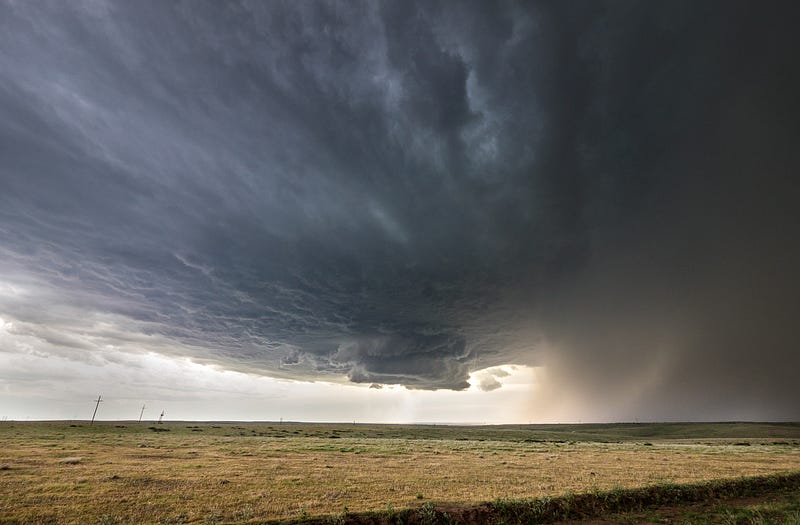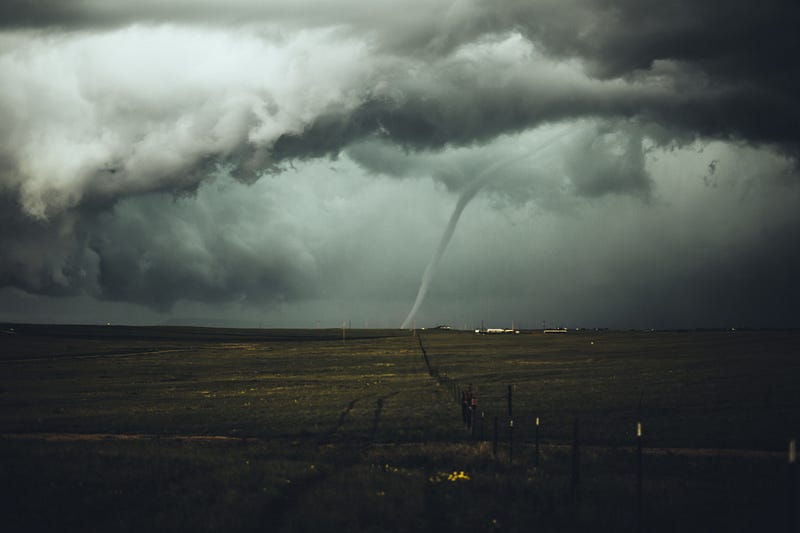Chasing Tornadoes: The Thrilling and Dangerous Profession
Written on
Chapter 1: Understanding Tornadoes
Tornadoes, often lasting less than ten minutes, are among nature's most chaotic phenomena. This has led to the emergence of a unique profession: tornado chasers. Equipped with cameras and specialized instruments, these individuals venture into the paths of tornadoes to study them up close. Although this activity may seem reckless, it plays a crucial role in advancing our understanding of meteorology.

The Formation of Tornadoes
The largest tornado ever recorded was the El Reno tornado of 2013, boasting a remarkable diameter of 4.2 km. Tornadoes do not occur randomly; they result from a specific set of atmospheric conditions. A critical factor in their formation is the temperature difference between two colliding air masses—typically warm, moist air from the equator and cold, dry air from the poles. This collision creates instability in the atmosphere, fostering the development of storm clouds.

Another significant element is wind shear, which refers to the variation in wind speed and direction with height. For tornadoes, vertical wind shear is particularly crucial. When winds of differing speeds and directions interact, they produce a horizontal rotation of air. This initial horizontal rotation, influenced by wind shear, can tilt vertically to create a rotating column of air—a precursor to a tornado.
As the funnel cloud descends and contacts the ground, the tornado reaches its peak intensity, with winds swirling violently at its center. Tornadoes can vary greatly in size and strength, from brief, small twisters to massive storms capable of causing extensive damage.
Chapter 2: The Role of Tornado Chasers
Tornadoes can achieve wind speeds exceeding 450 km/h, and approximately 1,200 tornadoes occur in the United States annually, making it one of the most tornado-prone countries. While some tornado chasers are professionals in fields like research or journalism, many pursue this passion alongside other careers. This demanding field requires a comprehensive understanding of meteorology, thorough preparation, and an acute awareness of the associated risks.
Tornado chasers collect essential data to analyze tornado formation, paths, and durations, which helps improve future weather predictions. By enhancing our understanding of tornadoes, these chasers can educate the public about safety protocols and contribute to building more resilient communities. Additionally, many tornado chasers capture stunning images of these natural events, showcasing their beauty amidst the chaos.

The Danger of Tornado Chasing
The 2013 El Reno tornado was notably destructive and marked the first recorded fatalities among professional tornado chasers. Tornadoes represent some of the most catastrophic weather phenomena, and chasing them is far from a game. When caught in a tornado-producing storm, the threat is ever-present. A tornado can rapidly approach, often providing little time for reaction, and can even lift vehicles into the air, hurling them hundreds of meters away.
The unpredictable nature of tornadoes poses a significant risk as they can change direction suddenly and without warning. Therefore, tornado chasers must be intimately familiar with the regions they traverse to avoid being caught off-guard. They utilize advanced forecasting tools and communication systems to anticipate tornado activity and respond promptly. Despite taking numerous precautions, they remain acutely aware of the dangers and are always prepared to seek shelter at the slightest sign of trouble.
Final Thoughts
Tornado Formation: Tornadoes arise from specific atmospheric conditions like temperature differences and wind shear, transitioning from horizontal to vertical rotation before touching down as devastating funnels.
Tornado Chasers' Impact: Despite the inherent risks, tornado chasing yields crucial data for meteorology, enhancing forecasting and public safety awareness. Many enthusiasts pursue this passion alongside their primary careers, driven by a profound commitment to understanding and documenting these phenomena.
Risks and Safety Measures: The pursuit of tornado chasing is fraught with danger; it has claimed lives, such as during the El Reno tornado in 2013. Chasers confront unpredictable storms that can lift vehicles and change course unexpectedly. They rely on expertise, advanced technology, and constant vigilance to minimize risks, prioritizing safety above all else.
Would you find the thrill of chasing tornadoes captivating or terrifying? Thank you for exploring this fascinating subject with me! Until next time.